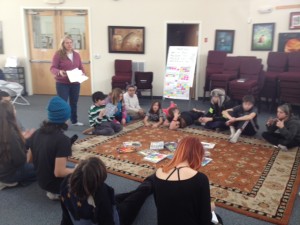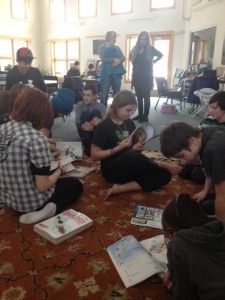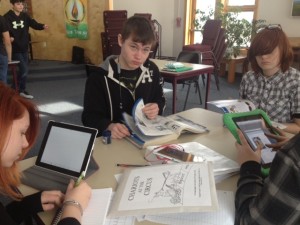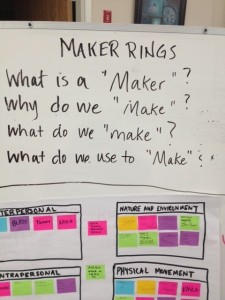Why and What
What is Making?
Today’s lesson was about the what, why and how of Making.
Our groups are established, ideas are beginning to flow and we are getting deeper.
We started with these questions:
What is a “Maker”?
Why do we “Make”?
What do we “Make”?
How is Art the same or different as Making?
How is Making the same or different as Art?
Our next question was, “What do we Make?”
- “We make something that makes life easier or more enjoyable.”
- “Make what you want!”
- “Make what makes you happy.”
- “I think we Make to solve a daily problem.”
- “We Make to improve other people’s lives.”
- “We Make to add to what others Make,
- “We like to build on what other people have made, but with our own unique spin.”
We moved to the question “Why do we Make?” and lots of hands went up to answer. Our teaching team was amazed at their responses as the conversation readily unfolded.
- “We want to be producers, instead of just consumers”, they said.
- “We make for ourselves.”
- “We make stuff for other people, to solve their problems.”
- “We make for our own enjoyment.”
- “We make for both ourselves AND other people.”
- “We make for the environment.”
- “We make to make things better in the world.”
- “We create to make functional art”.

It seemed their understanding of the reasons “Why” were quite sophisticated. The last statement, about functional art, led us to this question:
How is Art the same or different as Making?
How is Making the same or different as Art?
“They are the same because we make something better for ourselves and others.”
“Same, because we make things that are beautiful that we can use.”
“The same, because we make stuff to share with others.”
“You get the same sort of spiritual fulfillment if you make things you really like.”
“Making makes life easier; Art makes life more enjoyable.
Overall we had a very productive circle conversation about the whys and what’s of Making. We could have talked longer, but we were all excited to get to the next part of today’s class. We are starting to think about our projects, figure out what we need to make the stuff we want to make. We will start listing the items we need to be purchased for our portable Makerspace.

We started with a stack of catalogs and a few iPads. We have science and nature as well as robotics and electronics catalogs. If we didn’t have a catalog for the item we were looking for we used an iPad.

A diverse and eclectic list of projects is beginning to emerge. As they contemplated their projects we helped students figure out answers to questions like this:
I need to cut a piece of wood in a curve, what tool do I use? What should I put down?
Can we make something to use with something else that is already in existence?
(The answer was yes, of course.)
How much does 50 lbs of clay weigh? (for shipping costs)
I want to put a hole in this wood, how do I do that?
Our current list of project includes:
(this is always a works-in-progress, so we will see where these ideas lead us)
Rockets
Portable game console
Cardboard guitar
Paper lanterns
Making acrylic pain
Crocheting something
USING THE 3D PRINTER!
Remote control car with sound.
Making our own trailer to move around the Maker equipment when we go into community.
As we wrapped up our afternoon, stacked the catalogs, collected the iPads and gathered for discussion the room was abuzz with energy. Kids chatted enthusiastically with each other as they took advantage of the last few minutes left in class. As they describe and share their ideas to each other the ideas become clearer, and the network of students grows stronger. Teachers remarked on the excitement and momentum the project is gathering. When you allow students to have true agency in their school environment they can rise above your expectations. We are seeing that as we build our school program and community and explore these individualized approaches to learning.
